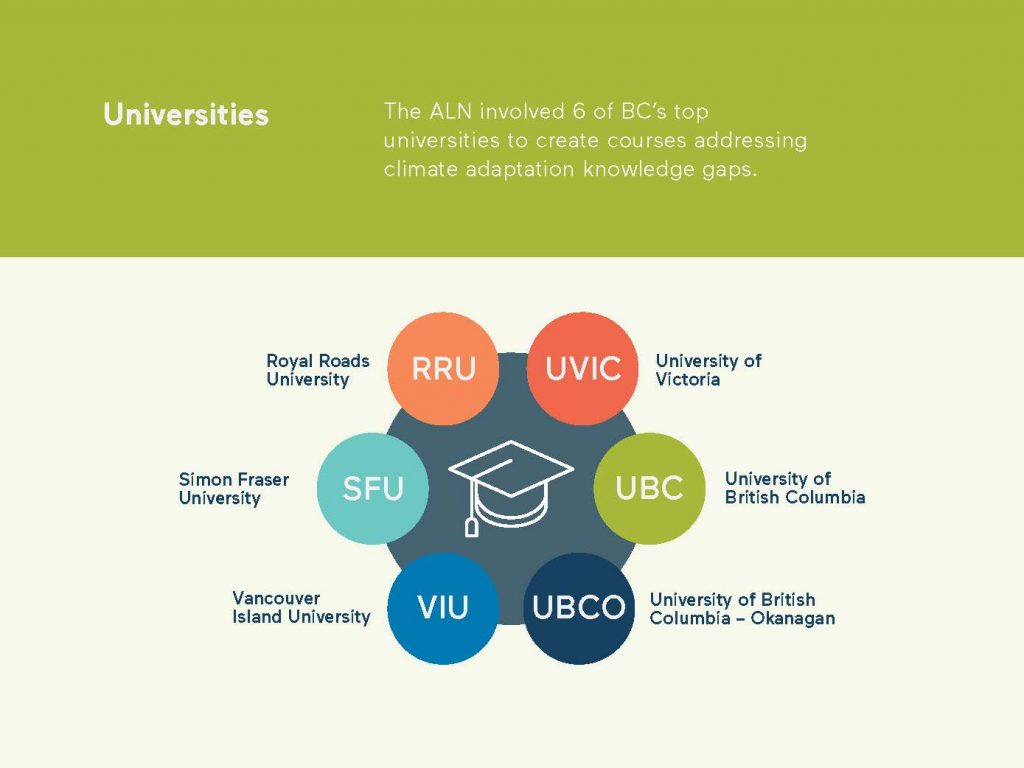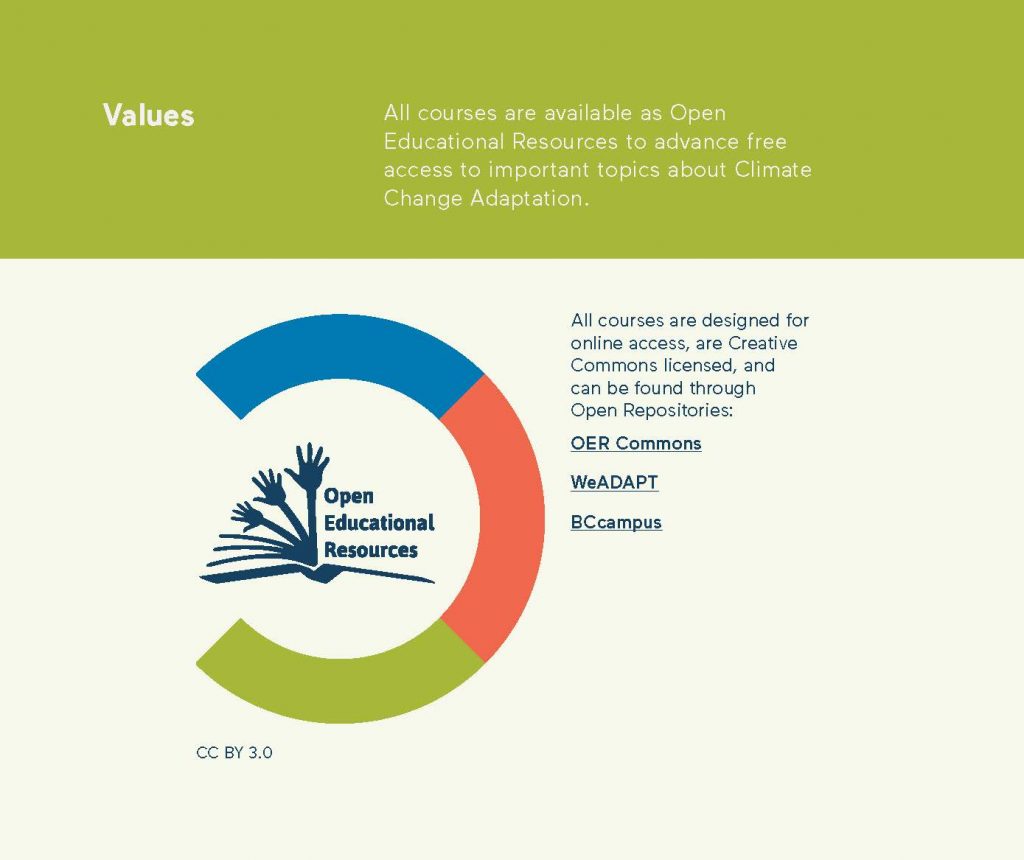

> Links to all ALN courses are in the LEFT “Contents” sidebar.
> 579 learners participated in 30 offerings of ALN courses, over a period of 15 months.
One of the three pillars of the Adaptation Learning Network project (e.g. competency framework, courses and professional learning network) was the development and teaching of a suite of 11 courses, designed to help professionals who work on the frontline of climate adaptation to develop the knowledge and skills to help their organizations anticipate and reduce the impact of climate change.
However, before we could dive into the challenging task of course development, we made a few key decisions that would significantly affect our approach and outcomes.
First, instead of creating and delivering all the courses in-house at Royal Roads University, we chose to partner with 6 other post-secondary institutions across British Columbia. Our rationale was simple – if we were going to make climate adaptation mainstream, we had to involve as many players and influencers as possible. By engaging a network of academic institutions, we hoped to not only build capacity amongst professionals but also among educators.

Second, we decided that all course materials and content would be open educational resources (OERs) – using Creative Commons copyright licenses, which would allow anyone in the world to reuse, remix and redistribute them. This was in line with our core philosophy of making it as easy as possible for learners and educators to use, share and build upon our materials. As the project leaders explain, when the planet is on fire, there’s no point in locking your fire-fighting tools in a shed where no one can use them.
 Third, rather than working only with academics at the universities, we also invited experts from the field to create courses to share their knowledge, skills and tools. We provided initial development funding of $11,000 per course to each course development team, which paid for a small fraction of their time. It’s worth noting that the final courses produced actually cost much more, closer to $25,000 each, much of which was offset by the provision of in-kind services by the participating universities.
Third, rather than working only with academics at the universities, we also invited experts from the field to create courses to share their knowledge, skills and tools. We provided initial development funding of $11,000 per course to each course development team, which paid for a small fraction of their time. It’s worth noting that the final courses produced actually cost much more, closer to $25,000 each, much of which was offset by the provision of in-kind services by the participating universities.

(Check out the feedback from ALN course instructors in the LEFT “Content” sidebar.)
However, since the courses would be open-licensed, we hoped the instructors would recoup some of their investment by continuing to teach them through various channels, once the project was complete.
With these core principles in place, we were ready to go.
As noted in the Discovery chapter, we spent the first 6 months of the project engaging with our partners and the climate adaptation community to identify the knowledge and skills that adaptation professionals needed, settling on a “short list” of 45 potential courses.
As we only had funding to develop about 10 courses, we had to make some tough choices. Rather than decide on our own, we took the list of 45 courses to our university partners and asked them which topics they’d like to develop and teach, based on their faculty’s expertise and interest. That brought us down to a list of 10 courses. In July 2019, we launched our course-building odyssey.
One of the first things we discovered was that every institution had different structures and systems for developing and delivering continuing studies courses. Some were quite advanced, while others were operating with just the bare bones of online course development, marketing support and registration systems capacity.
We realized we would have to provide some additional support, guidance and tools. So we spent the next 6 months producing toolkits to help the course subject matter experts (SMEs) who were developing the courses, navigate the challenges of building a course from scratch and setting it up for Creative Commons licensing.
We also decided to build an online course portal where we could keep all the information about each course so that potential learners could easily find course content summaries and registration information, serving as a one-stop-shop for marketing of ALN courses, regardless of which post-secondary institution was offering the course.
As we worked through these foundational tasks, we ran into the Great Shutdown. In March 2020, COVID swept across the world. While universities scrambled to pivot to emergency remote teaching, many were unable to stay focused on our project for a variety of reasons. Two of the original 8 universities withdrew from the project, while others stepped away for six months or more.
In addition to significantly delaying the roadmap for course development and launch, the pandemic forced us to change our delivery approach. Everything would have to go online. That worked well for some universities like Royal Roads University with 25 years of experience in online learning, but it was a real challenge for others.
Eventually, we launched our first course, Climate Change Adaptation Fundamentals, taught by IPCC scientist Dr. Stewart Cohen in October 2020. Over the next 12 months, we delivered all ten climate adaptation courses many times, for a total of 30 unique sessions in the period October 2020 – Dec 2021 (15 months).
We also partnered with Indigenuity Consulting Group, to develop a unique multi-media and open course with local Indigenous knowledge-keepers and elders to introduce learners to Indigenous perspectives on climate adaptation and on engagement with Indigenous communities. Our original goal was to have Indigenous partners work with us on all our courses to embed their critical perspectives. But the pandemic had everyone stretched so thin that we couldn’t make it happen.
After 18 months, we thought we were in good shape, all things considered. Then we realized that building the courses was only part of the challenge. While some of the universities had marketing setups that included things like Google ad placements for courses, others essentially relied on the course developers and instructors to market their courses through their own contact lists. If we wanted to maximize the impact of our suite of courses, we’d have to invest heavily in marketing.
So we shifted some funding and expanded the scope and reach of the third pillar of the project – building a professional learning network. Over the next 18 months, we developed sophisticated marketing strategies and tactics that expanded the market reach to potential learners.
Anecdotal feedback from participants in the courses was positive. Learners appreciated the practical, hands-on course style, as well as the integration of real-world tools and stories. But they weren’t the only ones learning. The courses provided incredible opportunities for experts to get a better understanding of participants’ needs and struggles.
Unfortunately, we weren’t able to gather any demographic or evaluation data from the courses, due to protection-of-privacy protocols and technical constraints at the universities.
As things unfolded, we also discovered that registration demand was tough to predict. Courses would fill up, but often not until a day or two before the start date. It’s unclear if this was due to the ongoing uncertainty caused by the pandemic, or perhaps the nature of trying to engage a population of extremely busy professionals.

Once we started to deliver the courses, we looked for ways to broaden their distribution and impact and found the perfect venue on the weADAPT website platform. It was already the recognized international hub for all things related to climate adaptation. So we spent several months working with them to create a new system for sharing courses on their platform. In addition, we migrated course content from “closed” learning management systems into open Pressbooks so the rich media elements worked as if the course was a live web-based course. These innovations were a major shift in focus for weADAPT, one we hope will inspire the hosting of additional course materials from many organizations on their website platform.
On top of providing best-in-class learning experiences for climate adaptation professionals, the course development phase of the ALN project created another unexpected outcome – a micro-credential strategy to enable learners to be certified for their newly-acquired skills and knowledge developed through the courses.
Looking ahead, we’re hopeful that this suite of ALN courses, offered through multiple post-secondary institutions, is just the beginning of a new movement to make climate adaptation learning mainstream through both public and private education and training providers.

